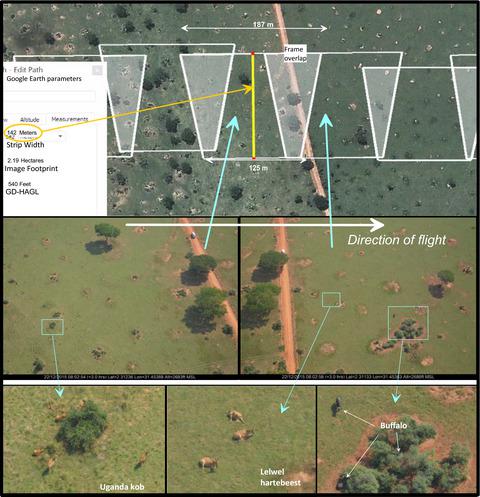当前位置:
X-MOL 学术
›
Remote Sens. Ecol. Conserv.
›
论文详情
Our official English website, www.x-mol.net, welcomes your
feedback! (Note: you will need to create a separate account there.)
Cameras replace human observers in multi‐species aerial counts in Murchison Falls, Uganda
Remote Sensing in Ecology and Conservation ( IF 3.9 ) Pub Date : 2020-03-15 , DOI: 10.1002/rse2.154 Richard Lamprey 1 , David Ochanda 2 , Rob Brett 3 , Charles Tumwesigye 4 , Iain Douglas‐Hamilton 1
Remote Sensing in Ecology and Conservation ( IF 3.9 ) Pub Date : 2020-03-15 , DOI: 10.1002/rse2.154 Richard Lamprey 1 , David Ochanda 2 , Rob Brett 3 , Charles Tumwesigye 4 , Iain Douglas‐Hamilton 1
Affiliation

|
Wildlife counts in Africa and elsewhere are often implemented using light aircraft with ‘rear‐seat‐observer’ (RSO) counting crews. Previous research has indicated that RSOs often fail to detect animals, and that population estimates are therefore biased. We conducted aerial wildlife surveys in Murchison Falls Protected Area, Uganda, in which we replaced RSOs with high‐definition ‘oblique camera count’ (OCC) systems. The survey area comprises forests, woodlands and grasslands. Four counts were conducted in 2015–2016 using a systematic‐reconnaissance‐flight (SRF) strip‐transect design. Camera inclination angles, focal lengths, altitude and frame interval were calibrated to provide imaged strips of known sample size on the left and right sides of the aircraft. Using digital cameras, 24 000 high‐definition images were acquired for each count, which were visually interpreted by four airphoto interpreters. We used the standard Jolly II SRF analysis to derive population estimates. Our OCC estimates of the antelopes – hartebeest, Uganda kob, waterbuck and oribi – were, respectively, 25%, 103%, 97% and 2100% higher than in the most recent RSO count conducted in 2014. The OCC surveys doubled the 2014 RSO estimate of 58 000 Uganda kob to over 118 000. Population size estimates of elephants and giraffes did not differ significantly. Although all four OCC buffalo estimates were higher than the RSO estimates – in one count by 60% – these differences were not significant due to the clumped distribution and high variation in herd sizes, resulting in imprecise estimation by sampling. We conclude that RSO wildlife counts in Murchison have been effective in enumerating elephants and giraffe, but that many smaller species have not been well detected. We emphasize the importance of 60 years of RSO‐based surveys across Africa, but suggest that new imaging technologies are embraced to improve accuracy.
中文翻译:

在乌干达默奇森福尔斯,照相机取代了人类在多种物种空中计数中的观察者
非洲和其他地方的野生动物计数通常是使用轻型飞机和“后座观察员”(RSO)计数人员来实现的。先前的研究表明,RSO通常无法检测到动物,因此种群估计存在偏差。我们在乌干达默奇森瀑布保护区进行了空中野生生物调查,在调查中,我们用高清“斜摄像机计数”(OCC)系统代替了RSO。调查区域包括森林,林地和草地。使用系统侦察飞行(SRF)条状样线设计在2015–2016年进行了四次计数。校准了相机的倾斜角度,焦距,高度和帧间隔,以在飞机的左侧和右侧提供已知样本大小的成像条。使用数码相机,每次计数可获取24000张高清图像,由四位航空摄影口译员在视觉上进行了解释。我们使用标准的Jolly II SRF分析得出人口估计数。我们对羚羊(羚羊,乌干达柯布,羚羊和)的OCC估算分别比2014年最新的RSO计数高25%,103%,97%和2100%。OCC调查将2014年RSO翻了一番估计有58 000乌干达科布到超过118000。大象和长颈鹿的人口估计没有显着差异。尽管所有四个OCC水牛的估算值都比RSO的估算值高(一个计数提高了60%),但由于分布不均和畜群大小的高度差异,这些差异并不明显,从而导致抽样估算不准确。我们得出的结论是,默奇森的RSO野生动物数量在列举大象和长颈鹿方面非常有效,但是还没有发现很多较小的物种。我们强调了在非洲开展基于RSO的60年调查的重要性,但建议采用新的成像技术来提高准确性。
更新日期:2020-03-15
中文翻译:

在乌干达默奇森福尔斯,照相机取代了人类在多种物种空中计数中的观察者
非洲和其他地方的野生动物计数通常是使用轻型飞机和“后座观察员”(RSO)计数人员来实现的。先前的研究表明,RSO通常无法检测到动物,因此种群估计存在偏差。我们在乌干达默奇森瀑布保护区进行了空中野生生物调查,在调查中,我们用高清“斜摄像机计数”(OCC)系统代替了RSO。调查区域包括森林,林地和草地。使用系统侦察飞行(SRF)条状样线设计在2015–2016年进行了四次计数。校准了相机的倾斜角度,焦距,高度和帧间隔,以在飞机的左侧和右侧提供已知样本大小的成像条。使用数码相机,每次计数可获取24000张高清图像,由四位航空摄影口译员在视觉上进行了解释。我们使用标准的Jolly II SRF分析得出人口估计数。我们对羚羊(羚羊,乌干达柯布,羚羊和)的OCC估算分别比2014年最新的RSO计数高25%,103%,97%和2100%。OCC调查将2014年RSO翻了一番估计有58 000乌干达科布到超过118000。大象和长颈鹿的人口估计没有显着差异。尽管所有四个OCC水牛的估算值都比RSO的估算值高(一个计数提高了60%),但由于分布不均和畜群大小的高度差异,这些差异并不明显,从而导致抽样估算不准确。我们得出的结论是,默奇森的RSO野生动物数量在列举大象和长颈鹿方面非常有效,但是还没有发现很多较小的物种。我们强调了在非洲开展基于RSO的60年调查的重要性,但建议采用新的成像技术来提高准确性。











































 京公网安备 11010802027423号
京公网安备 11010802027423号